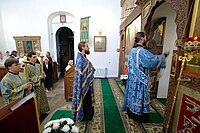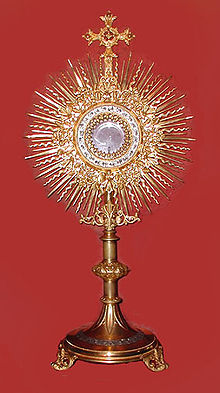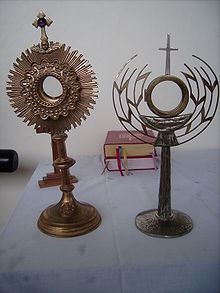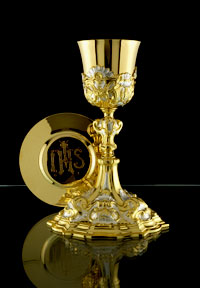A thurible is a metal censer suspended from chains, in which incense is burned during worship services. It is used in Christian churches including the Roman Catholic, Eastern Orthodox, Armenian Apostolic and Oriental Orthodox, as well as in some Lutheran, Old Catholic, and Anglican churches (with its use almost universal amongst Anglo Catholic Anglican churches). In Roman Catholic, Lutheran, and Anglican churches, the altar server who carries the thurible is called the thurifer. The practice is rooted in the earlier traditions of Judaism in the time of the Second Jewish Temple.[1]
Beyond its ecclesiastical use, the thurible is also employed in various other spiritual or ceremonial traditions, including some Gnostic Churches, Freemasonry[2] (especially in the consecration of new lodges), and in Co-Freemasonry. Thuribles are sometimes employed in the practice of ceremonial magic.[3][4]

The workings of a thurible are quite simple. Each thurible consists of a censer section, chains (typically three or four, although single-chain thuribles also exist), a metal ring around the chains (used to lock the lid of the censer section in place), and usually (although not always) a removable metal crucible in which the burning charcoals are placed. Many thuribles are supplied with a stand, allowing the thurible to be hung safely when still hot, but not in use. Burning charcoal is placed inside the metal censer, either directly into the bowl section, or into a removable crucible if supplied, and incense (of which there are many different varieties) is placed upon the charcoal, where it melts to produce a sweet smelling smoke. This may be done several times during the service as the incense burns quite quickly. Once the incense has been placed on the charcoal the thurible is then closed and used for censing.[5]
A famous thurible is the huge Botafumeiro in Santiago de Compostela Cathedral, Spain[5]
The word "thurible" comes from the Old French thurible, which in turn is derived from the Latin term thuribulum. The Latin thuribulum is further formed from the root thus, meaning incense. Thus is an alteration of the Greek word θύος (thuos), which is derived from θύειν (thuein) "to sacrifice".[5]
The number of swings of the thurible to be used when incensing persons or objects is specified in the General Instruction of the Roman Missal:
These rules, except for the manner of incensing the offerings at Mass, applied also before 1969. Earlier editions of the Roman Missal prescribe that the offerings be incensed by forming over them with the thurible first three crosses and then three circles, the first two anticlockwise and last clockwise, while also saying a prescribed prayer.[8] They also direct that incensing of the altar be done with single swings at 29 designated points of an altar attached to the rear wall of the sanctuary, and at 22 points of a freestanding altar.[5]
Pre-1969 editions of the Roman Missal did not allow the use of incense at Low Mass.
In accordance with the conditions laid down in the document Summorum Pontificum of 2007, use of the 1962 edition as an extraordinary form of the Roman Rite is permitted. Other extraordinary forms such as that employed by the Congregation of Mary Immaculate Queen, who call the 1962 version "mutilated and deformed",[9] are not authorized.
In the Anglican Communion, the use of incense is a fairly reliable[citation needed] guide to how 'high' (more Catholic in liturgical style) or how 'low' (more Protestant) a church is. Anglo-Catholic
churches may use generous quantities of incense. In recent years, some
middle-of-the-road Anglican churches have taken to using incense a few
times a year for special occasions.
Traditionally, at High Mass, the following rule is observed when censing, which differs from the common Roman Rite:
At the elevations of the Blessed Sacrament, during the prayer of consecration, either the deacon, sub-deacon, or other appropriate person (including the thurifer), makes three sets of triple swings, as the parish bell and sanctuary bells are rung.
Should the Regina Coeli (during Easter) or the Angelus be said or sung, then the celebrant or other appropriate person may cense the statue of the Blessed Virgin Mary in the following form:
The Eastern Orthodox Church and the Byzantine Rite Eastern Catholic Churches make frequent use of incense, not only at the Divine Liturgy [5] (Eucharist), but also at Vespers, Matins and a number of other occasional services (see Euchologion). During funeral services and memorial services (Panikhida), the censer is swung almost continuously.
Incense is understood as symbolizing the sanctifying grace of the Holy Spirit and the prayers of the Saints rising to heaven. Incense is offered by the priest or deacon during the services. In some traditions, the ecclesiarch (sacristan) and his assistant (paraecclesiarch) will perform the censing at specific moments of the service.
The thurible (Greek: Θυμιατο, Thymiato; Church Slavonic: Кадилница, kadilnitsa) used is often gold plated (combining in itself at the offering of incense the three gifts of the Biblical Magi: gold, frankincense, and myrrh). The thurible consists of a metal bowl (usually with a base so it can stand upright) into which the charcoal and incense are placed, and a lid (often topped with a cross), pierced by holes to allow the fragrance from the incense to escape. The censer will usually have three outer chains (for the Holy Trinity) attached to the bowl, and a fourth inner chain (for the Oneness of God) attached to the lid. The three outer chains are gathered together and attached to a round conical plate attached to a ring; the inner chain passes through a hole in the conical plate and is attached to another ring to make it easier to lift the lid. In the Greek and some Russian practice twelve bells will be attached to the chains (their ringing symbolizes the teaching of the twelve Apostles).[5] Sometimes the bowl and lid of the thurible are decorated with crosses or icons in repousse, and may even be decorated with semi-precious stones. When not in use the thurible is usually hung from a hook in the sanctuary.
When censing, the priest or deacon holds the censer below the conical plate with only one hand (the right hand) allowing it to swing freely. He will make the Sign of the Cross with the censer by making two vertical swings and a third horizontal swing (the three swings together symbolizing the Holy Trinity).
When the temple (church building) is censed, the priest or deacon will move in a sunwise (clockwise) direction, moving to his right as he censes in order the Holy Table (altar), sanctuary, Iconostasis, walls of the temple, clergy and faithful. There are two types of censing: a Greater Censing (which encompasses the entire temple and all of the people therein), and a Lesser Censing (which, depending upon the liturgical context, consists of censing only a portion of the temple and the people).
During some censings, especially the Greater Censing, the clergyman who is performing the censing will often carry a candle in his left hand. During Bright Week (the week which begins on Easter Sunday) the priest and the deacon will carry special Paschal candles at every censing, even the Lesser Censing. While carrying the Paschal candles, the priest or deacon will greet the members of the congregation with the Paschal greeting while censing them. Simple tapers are carried while censing during funerals and memorial services.
During the Eastern Roman Empire (Byzantine Empire) the emperor used to be permitted to offer incense on the Feast of the Nativity (no doubt as a memorial of the gifts of the Magi), but was permitted to perform no other priestly function.
If no priest is available, incense may be offered by a reader or senior layman, but with a hand censer which has no chains on it, but rather a handle (it often has bells as well, suspended from the handle or around the rim). The hand censer is also used in some monasteries even when a priest is present for certain censings which are done by a monastic other than a vested priest or deacon.
During Holy Week it is customary in some places for even the priest and deacon to use the hand censer for all of the censings, as a sign of humility and mourning at the Passion of Christ.
The faithful will often burn incense, using a hand censer, in the home during Morning and Evening Prayers, and it is not unusual for the head of the household to bless the Holy Icons and all of the members of the household with a hand censer.
Beyond its ecclesiastical use, the thurible is also employed in various other spiritual or ceremonial traditions, including some Gnostic Churches, Freemasonry[2] (especially in the consecration of new lodges), and in Co-Freemasonry. Thuribles are sometimes employed in the practice of ceremonial magic.[3][4]

The workings of a thurible are quite simple. Each thurible consists of a censer section, chains (typically three or four, although single-chain thuribles also exist), a metal ring around the chains (used to lock the lid of the censer section in place), and usually (although not always) a removable metal crucible in which the burning charcoals are placed. Many thuribles are supplied with a stand, allowing the thurible to be hung safely when still hot, but not in use. Burning charcoal is placed inside the metal censer, either directly into the bowl section, or into a removable crucible if supplied, and incense (of which there are many different varieties) is placed upon the charcoal, where it melts to produce a sweet smelling smoke. This may be done several times during the service as the incense burns quite quickly. Once the incense has been placed on the charcoal the thurible is then closed and used for censing.[5]
A famous thurible is the huge Botafumeiro in Santiago de Compostela Cathedral, Spain[5]
The word "thurible" comes from the Old French thurible, which in turn is derived from the Latin term thuribulum. The Latin thuribulum is further formed from the root thus, meaning incense. Thus is an alteration of the Greek word θύος (thuos), which is derived from θύειν (thuein) "to sacrifice".[5]
Roman Rite
The Roman Missal, as revised in 1969, allows the use of incense at any Mass: in the entrance procession; at the beginning of Mass to incense the cross and the altar; at the Gospel procession and proclamation; after the bread and the chalice have been placed upon the altar, to incense the offerings, the cross, and the altar, as well as the priest and the people; at the elevation of the host and the chalice after the consecration.[6]The number of swings of the thurible to be used when incensing persons or objects is specified in the General Instruction of the Roman Missal:
- Three double swings: the Most Blessed Sacrament, a relic of the Holy Cross and images of the Lord exposed for public veneration, the offerings for the sacrifice of the Mass, the altar cross, the Book of the Gospels, the Paschal Candle, the priest, and the people.
- Two double swings (and only at the beginning of the celebration, after the incensing of the altar): relics and images of the Saints exposed for public veneration.
- A series of single swings: the altar.
- The priest may incense the offerings for Mass by tracing a cross over them with the thurible instead of using three swings of the thurible,[7]
- Holding the thurible open to enable the priest to put incense in it, after which he blesses it with the sign of the cross without using any formula of words.
- Carrying the thurible in procession (gently swinging if needed to keep the charcoal burning).
- Presenting the thurible to the priest or deacon when they need to use it
- Incensing (in the absence of a deacon) the priest after the priest has incensed the offering at Mass.
These rules, except for the manner of incensing the offerings at Mass, applied also before 1969. Earlier editions of the Roman Missal prescribe that the offerings be incensed by forming over them with the thurible first three crosses and then three circles, the first two anticlockwise and last clockwise, while also saying a prescribed prayer.[8] They also direct that incensing of the altar be done with single swings at 29 designated points of an altar attached to the rear wall of the sanctuary, and at 22 points of a freestanding altar.[5]
Pre-1969 editions of the Roman Missal did not allow the use of incense at Low Mass.
In accordance with the conditions laid down in the document Summorum Pontificum of 2007, use of the 1962 edition as an extraordinary form of the Roman Rite is permitted. Other extraordinary forms such as that employed by the Congregation of Mary Immaculate Queen, who call the 1962 version "mutilated and deformed",[9] are not authorized.
Ambrosian Rite
In the Ambrosian Rite the thurible has no top cover, and is swung clockwise before the censing of a person or object.[10]Anglicanism
Boat bearer with incense boat
Traditionally, at High Mass, the following rule is observed when censing, which differs from the common Roman Rite:
- Three sets of triple swings: When censing the Most Blessed Sacrament
- Three sets of double swings: When censing images, relics, and other sacramentals, also when censing the celebrant.
- Two sets of double swings: When censing a Deacon.
- One set of double swings: When censing a Sub-Deacon.
- Three sets of single swings: When censing the congregation
- After venerating the altar, the Priest receives the thurible from the server at the North end of the altar.
- The Priest circles the altar, making small movements in the thurible, in an anti-clockwise direction until s/he reaches the west side of the altar, facing east.
- The Priest then makes three sets of triple swings towards east, then continues around the altar to his original position facing west.
- The Priest makes 6 swings (3+3) over the gifts, making the sign of the cross.
- The Priest then makes 3 circles, two counter-clockwise and one clockwise, over and around the gifts.
At the elevations of the Blessed Sacrament, during the prayer of consecration, either the deacon, sub-deacon, or other appropriate person (including the thurifer), makes three sets of triple swings, as the parish bell and sanctuary bells are rung.
Should the Regina Coeli (during Easter) or the Angelus be said or sung, then the celebrant or other appropriate person may cense the statue of the Blessed Virgin Mary in the following form:
- Regina Coeli: Three sets of triple swings during the verse (Joy to thee, O Queen of Heaven, Alleluia...) and then three sets of triple swings during the concluding prayer.
- Angelus: One set of triple swings during each 'Ave Maria', then three sets of triple swings during the prayer (Pour forth, we beseech thee, thy grace into our hearts...)
Orthodox and Eastern Catholic Rites
An Eastern Orthodox censer, gold with four chains and bells.
Armenian Church, Kolkata
Incense is understood as symbolizing the sanctifying grace of the Holy Spirit and the prayers of the Saints rising to heaven. Incense is offered by the priest or deacon during the services. In some traditions, the ecclesiarch (sacristan) and his assistant (paraecclesiarch) will perform the censing at specific moments of the service.
The thurible (Greek: Θυμιατο, Thymiato; Church Slavonic: Кадилница, kadilnitsa) used is often gold plated (combining in itself at the offering of incense the three gifts of the Biblical Magi: gold, frankincense, and myrrh). The thurible consists of a metal bowl (usually with a base so it can stand upright) into which the charcoal and incense are placed, and a lid (often topped with a cross), pierced by holes to allow the fragrance from the incense to escape. The censer will usually have three outer chains (for the Holy Trinity) attached to the bowl, and a fourth inner chain (for the Oneness of God) attached to the lid. The three outer chains are gathered together and attached to a round conical plate attached to a ring; the inner chain passes through a hole in the conical plate and is attached to another ring to make it easier to lift the lid. In the Greek and some Russian practice twelve bells will be attached to the chains (their ringing symbolizes the teaching of the twelve Apostles).[5] Sometimes the bowl and lid of the thurible are decorated with crosses or icons in repousse, and may even be decorated with semi-precious stones. When not in use the thurible is usually hung from a hook in the sanctuary.
When censing, the priest or deacon holds the censer below the conical plate with only one hand (the right hand) allowing it to swing freely. He will make the Sign of the Cross with the censer by making two vertical swings and a third horizontal swing (the three swings together symbolizing the Holy Trinity).
When the temple (church building) is censed, the priest or deacon will move in a sunwise (clockwise) direction, moving to his right as he censes in order the Holy Table (altar), sanctuary, Iconostasis, walls of the temple, clergy and faithful. There are two types of censing: a Greater Censing (which encompasses the entire temple and all of the people therein), and a Lesser Censing (which, depending upon the liturgical context, consists of censing only a portion of the temple and the people).
During some censings, especially the Greater Censing, the clergyman who is performing the censing will often carry a candle in his left hand. During Bright Week (the week which begins on Easter Sunday) the priest and the deacon will carry special Paschal candles at every censing, even the Lesser Censing. While carrying the Paschal candles, the priest or deacon will greet the members of the congregation with the Paschal greeting while censing them. Simple tapers are carried while censing during funerals and memorial services.
During the Eastern Roman Empire (Byzantine Empire) the emperor used to be permitted to offer incense on the Feast of the Nativity (no doubt as a memorial of the gifts of the Magi), but was permitted to perform no other priestly function.
If no priest is available, incense may be offered by a reader or senior layman, but with a hand censer which has no chains on it, but rather a handle (it often has bells as well, suspended from the handle or around the rim). The hand censer is also used in some monasteries even when a priest is present for certain censings which are done by a monastic other than a vested priest or deacon.
During Holy Week it is customary in some places for even the priest and deacon to use the hand censer for all of the censings, as a sign of humility and mourning at the Passion of Christ.
The faithful will often burn incense, using a hand censer, in the home during Morning and Evening Prayers, and it is not unusual for the head of the household to bless the Holy Icons and all of the members of the household with a hand censer.



































